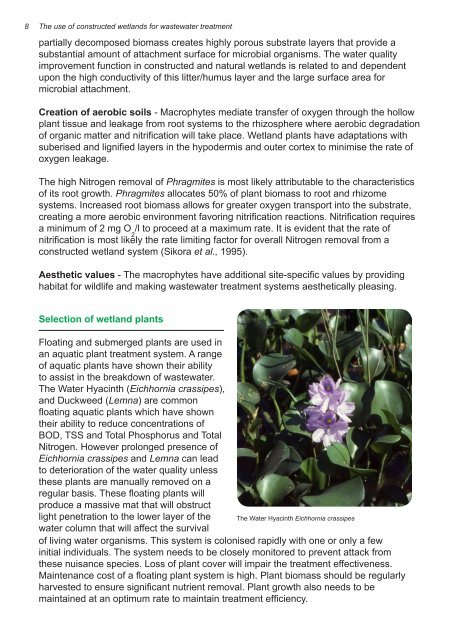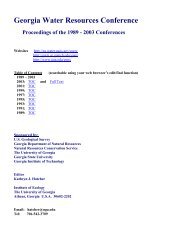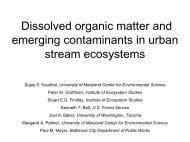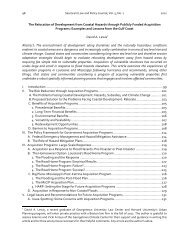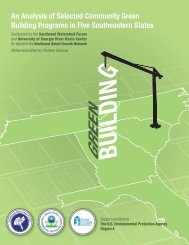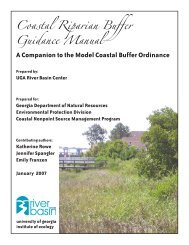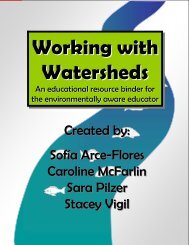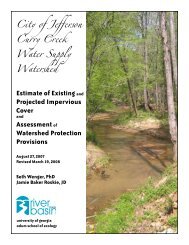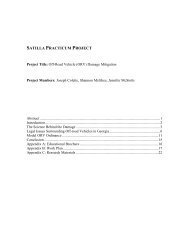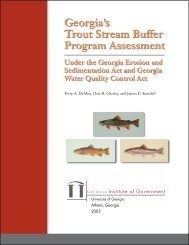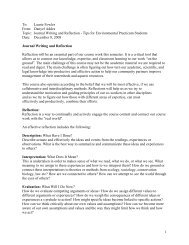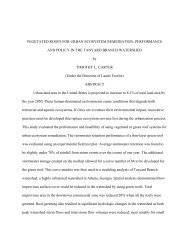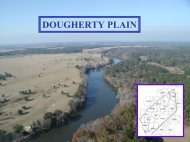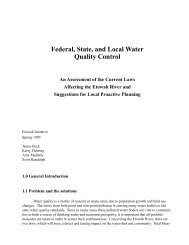The use of constructed wetlands for wastewater treatment
The use of constructed wetlands for wastewater treatment
The use of constructed wetlands for wastewater treatment
You also want an ePaper? Increase the reach of your titles
YUMPU automatically turns print PDFs into web optimized ePapers that Google loves.
8 <strong>The</strong> <strong>use</strong> <strong>of</strong> <strong>constructed</strong> <strong>wetlands</strong> <strong>for</strong> <strong>wastewater</strong> <strong>treatment</strong><br />
partially decomposed biomass creates highly porous substrate layers that provide a<br />
substantial amount <strong>of</strong> attachment surface <strong>for</strong> microbial organisms. <strong>The</strong> water quality<br />
improvement function in <strong>constructed</strong> and natural <strong>wetlands</strong> is related to and dependent<br />
upon the high conductivity <strong>of</strong> this litter/humus layer and the large surface area <strong>for</strong><br />
microbial attachment.<br />
Creation <strong>of</strong> aerobic soils - Macrophytes mediate transfer <strong>of</strong> oxygen through the hollow<br />
plant tissue and leakage from root systems to the rhizosphere where aerobic degradation<br />
<strong>of</strong> organic matter and nitrification will take place. Wetland plants have adaptations with<br />
suberised and lignified layers in the hypodermis and outer cortex to minimise the rate <strong>of</strong><br />
oxygen leakage.<br />
<strong>The</strong> high Nitrogen removal <strong>of</strong> Phragmites is most likely attributable to the characteristics<br />
<strong>of</strong> its root growth. Phragmites allocates 50% <strong>of</strong> plant biomass to root and rhizome<br />
systems. Increased root biomass allows <strong>for</strong> greater oxygen transport into the substrate,<br />
creating a more aerobic environment favoring nitrification reactions. Nitrification requires<br />
a minimum <strong>of</strong> 2 mg O<br />
2<br />
/l to proceed at a maximum rate. It is evident that the rate <strong>of</strong><br />
nitrification is most likely the rate limiting factor <strong>for</strong> overall Nitrogen removal from a<br />
<strong>constructed</strong> wetland system (Sikora et al., 1995).<br />
Aesthetic values - <strong>The</strong> macrophytes have additional site-specific values by providing<br />
habitat <strong>for</strong> wildlife and making <strong>wastewater</strong> <strong>treatment</strong> systems aesthetically pleasing.<br />
Selection <strong>of</strong> wetland plants<br />
Floating and submerged plants are <strong>use</strong>d in<br />
an aquatic plant <strong>treatment</strong> system. A range<br />
<strong>of</strong> aquatic plants have shown their ability<br />
to assist in the breakdown <strong>of</strong> <strong>wastewater</strong>.<br />
<strong>The</strong> Water Hyacinth (Eichhornia crassipes),<br />
and Duckweed (Lemna) are common<br />
floating aquatic plants which have shown<br />
their ability to reduce concentrations <strong>of</strong><br />
BOD, TSS and Total Phosphorus and Total<br />
Nitrogen. However prolonged presence <strong>of</strong><br />
Eichhornia crassipes and Lemna can lead<br />
to deterioration <strong>of</strong> the water quality unless<br />
these plants are manually removed on a<br />
regular basis. <strong>The</strong>se floating plants will<br />
produce a massive mat that will obstruct<br />
light penetration to the lower layer <strong>of</strong> the <strong>The</strong> Water Hyacinth Eichhornia crassipes<br />
water column that will affect the survival<br />
<strong>of</strong> living water organisms. This system is colonised rapidly with one or only a few<br />
initial individuals. <strong>The</strong> system needs to be closely monitored to prevent attack from<br />
these nuisance species. Loss <strong>of</strong> plant cover will impair the <strong>treatment</strong> effectiveness.<br />
Maintenance cost <strong>of</strong> a floating plant system is high. Plant biomass should be regularly<br />
harvested to ensure significant nutrient removal. Plant growth also needs to be<br />
maintained at an optimum rate to maintain <strong>treatment</strong> efficiency.


